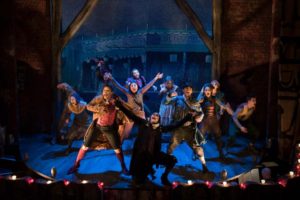
Based on the classic novel by Victor Hugo, Tom Morris’ direction of the Grinning Man; written by Carl Grose with score by Tim Phillips and Marc Teitler is a unique story told at the heart of the West end in Trafalgar Square neglecting the usual audience pleasing fairy-tale templates. The story was told with a huge variety of creative yet engrossing techniques and mediums from the use of clowning to the expert puppetry all supporting the story telling of the unique story which came alive through many a medium.
The Trafalgar studio was packed thrice the volume of when I saw the Philanthropist earlier this year and the reason was clear from entering the auditorium: Jon Bausor, set designer, had turned the Trafalgar Studio 1 into a fairground circus with posters and fliers lining the walls, bunting and macabre fairy lights littered the upper space – the closest thing to a portal out of London had been created!

As I sat in a packed auditorium amongst tourists, avid theatre goers and well-known actors, we were all treated with the same status by Julian Bleach playing Barkilphedro, the court’s clown introducing the folly along with the characters keeping within the rules of good ol’ Freytag’s structure – to my surprise, despite the leap from introduction into sung introduction, the story was still told clearly and the new medium didn’t distract from the storytelling and perhaps even furthered the narrative as the repetition of lyrics enhanced our knowledge of the given circumstances introduced.

The pace of the first act was perfect as it did not take too long until we were introduced to Ursus played by Sean Kingsley, whose band of performers and puppeteers retold the tale of the Grinning man leaving out guilty details which Ursus did not yet want to reveal to the audience or his performers; this idea of multiple worlds was manipulated effectively by Kingsley who acknowledged and appreciated from the get-go that he was telling the story not only to Trelawny visiting his “show” but also to us audience experiencing this show within a show and this was easily set up by Kingsley agreeing that “this will be a private performance, with the exception of you few on-lookers”. The exciting action to follow was sharp and snappy as the puppets of GrinPayne and Dea were made the vulnerable source of our entertainment as the story unfolded of how the past became the present in which the puppets were left to the show within the show and the actors took the present role of GrinPayne and Dea; this clarity of past and present gave the story an immersive experience as it was easy to feel sorry for the puppets and relate this to what the present characters had suffered.

Overall I think that the execution of the play was greatly entertaining and at times affected the audience in ways beyond ‘just a play’, however I think the second act lacked a new exciting force meaning that there was a hole between the climax and the resolution.
Get The Chance has a firm but friendly comments policy.
